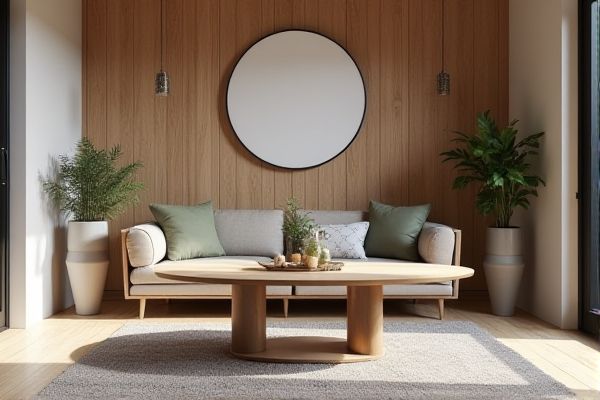
Oval tables offer a softer, more inviting aesthetic and allow for easier movement around the edges, making them ideal for creating a cozy and inclusive dining experience. Discover which table shape best suits your space and lifestyle by reading the rest of the article.
Table of Comparison
| Feature | Oval Table | Rectangular Table |
|---|---|---|
| Shape | Rounded edges, elongated oval | Straight edges, four right angles |
| Space Efficiency | Better flow in tight spaces | Maximizes seating capacity |
| Seating Capacity | Comfortable for 4-8 people | Accommodates 4-10 or more people |
| Design Style | Soft, elegant, modern or traditional | Classic, formal, versatile |
| Safety | Rounded edges reduce injury risk | Sharp corners may pose hazard |
| Functionality | Ideal for conversation, flow | Suitable for dining, work, multi-use |
| Placement | Best in small to medium rooms | Fits large or rectangular rooms well |
| Visual Appeal | Softens room angles, modern look | Structured, formal appearance |
Overview: Oval vs Rectangular Tables
Oval tables offer a smooth, rounded shape that encourages social interaction and maximizes seating flexibility in compact spaces. Rectangular tables provide a classic design ideal for formal dining or work settings, offering clear edges that facilitate placement against walls in rooms with constrained layouts. Your choice depends on room size, seating needs, and the ambiance you want to create, with oval tables promoting intimacy and rectangular tables enhancing structure.
Key Design Differences
Oval tables feature smooth, curved edges that promote a softer, more organic aesthetic and encourage easier movement around the table, while rectangular tables have straight lines and sharp angles, offering a more formal and structured look. The key design difference lies in their shape, with oval tables creating a more intimate and inclusive seating arrangement, whereas rectangular tables maximize seating capacity and fit well in narrow spaces. Your choice depends on the room layout and the desired ambiance, balancing style with functionality.
Space Efficiency Comparison
Oval tables maximize usable space with smooth edges, allowing easier movement and better flow in compact rooms compared to rectangular tables, which often require more clearance at corners. Rectangular tables provide more defined seating arrangements and can accommodate more people linearly, making them ideal for narrow dining areas. Your choice depends on room shape and traffic patterns, with oval tables offering superior space efficiency in tight or irregular layouts.
Seating Capacity and Arrangement
Oval tables offer more flexible seating arrangements, comfortably accommodating six to eight people by allowing easier movement around the curved edges. Rectangular tables typically provide a more structured seating capacity, ranging from four to ten individuals, with guests seated along the longer sides and at the ends. The continuous surface of an oval table can promote better social interaction by minimizing sharp corners and maximizing usable space.
Aesthetic Appeal and Style
Oval tables offer a softer, more elegant aesthetic that complements contemporary and traditional interiors with their smooth curves and balanced proportions. Rectangular tables provide a classic, structured look that enhances formality and symmetry, making them ideal for dining rooms needing clear visual lines. Your choice depends on whether you prefer the inviting flow of an oval shape or the timeless, defined presence of a rectangular design.
Suitability for Different Room Shapes
Oval tables enhance flow and maximize space in narrow or smaller rooms due to their rounded edges, reducing sharp corners. Rectangular tables are ideal for long, spacious rooms, accommodating more people and fitting well against walls. Your choice depends on the room's shape and space efficiency preferences.
Functionality and Practical Uses
Oval tables provide versatile seating arrangements by eliminating sharp corners, enhancing flow in tight spaces and promoting easier movement around the table. Rectangular tables offer maximum surface area for accommodating larger groups or spreading out materials, making them ideal for formal dining or workspace settings. Both shapes support various functions, but oval tables excel in compact, casual environments while rectangular tables suit structured, multifunctional purposes.
Safety Considerations
Oval tables reduce the risk of injury due to their rounded edges, making them safer in homes with children or elderly individuals compared to rectangular tables with sharp corners. The absence of pointed edges minimizes accidental bumps and bruises, which is a common concern in busy household environments. Choosing an oval table enhances safety while maintaining functional dining space and aesthetic appeal.
Maintenance and Durability
Oval tables typically offer easier maintenance due to their smooth, rounded edges that resist chipping and reduce dust accumulation. Rectangular tables may require more frequent upkeep, especially on sharp corners prone to wear and damage, but they often provide enhanced durability with robust construction suited for heavy use. Choosing between the two depends on balancing aesthetic preferences with practical considerations for long-term care and surface resilience.
Choosing the Right Table for Your Home
Oval tables offer a softer aesthetic with curved edges that promote better flow and easier movement around the furniture, making them ideal for smaller or irregularly shaped rooms. Rectangular tables provide a more formal look with maximum seating capacity, perfect for large dining spaces or long gatherings. Evaluating room dimensions, seating needs, and style preferences ensures the choice between oval and rectangular tables complements your home's layout and functionality.
 homyna.com
homyna.com